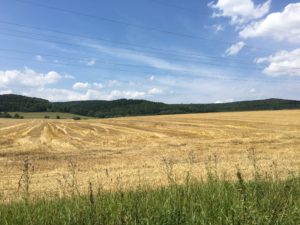
The weather forecast had said something about temperatures in the 30’s – Celsius, of course, which translates to high 80s and 90s in Fahrenheit. I know I have some good hills coming up, so I make sure both my water bottles are filled, and buy a bottle of Apfelschorle (apple spritz) at a small store. There are no towns on the map for the next ten kilometers, except for the two marked as razed villages. I have “seen” razed villages during earlier visits to the former border – except that there is nothing to see.
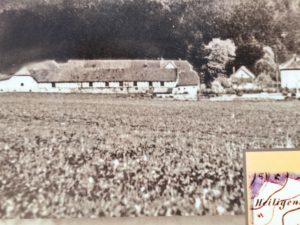
It is eery – you can be in a beautiful place, enjoying the view of a field or meadow – and then you notice a marker or an interpretive sign informing you that this land used to belong to family XYZ, and that they were relocated because their house or their fields were too close to the border. At least 11,000 people were relocated in the course of the two main “operations” in 1952 and 1961, often with barely a few hours’ notice. To add insult to injury, neighbors in the receiving towns farther inland were told that the newcomers were “criminal elements”.
The two villages along today’s route were razed in the early 1970s in the course of border “improvements”. I wonder how their former residents dealt with the trauma of this kind of disruption, but of course there is no one to ask. So I continue on my way, hot air streaming by me as if there were a giant blow dryer hidden at the edge of the woods. An excellent excuse to buy an ice cream in the next town, Vacha, where I locate the site of another border absurdity I had read about.
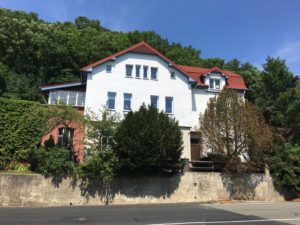
Vacha is located on the Werra River, with the former border crossing the river at an angle. Today, a bridge leads right up to the house shown on the left. In 1890, the publisher of the regional daily paper, the Rhön-Zeitung, built the house and a print shop right on the edge of a prior version of today’s federal state of Hesse that bordered Thuringia (to explain this would require a major detour – click on the link to get an idea of the crazy quilt of German territories over the centuries!). This “old” border was not nearly as big a deal as the one that came with the division of Germany after WWII, and in 1928 the Hossfeld family even built an addition onto Thuringian territory and placed its printing machines into that part of the building.
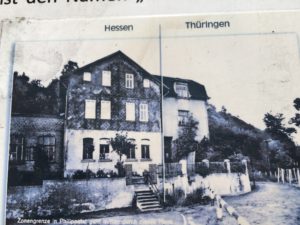
Well, this did become a big deal when the border became part of the Iron Curtain. Fearing expropriation of their business, the Hossfelds moved the printing machines to the Hessian side of the building on New Year’s Eve of 1951/52 and bricked up the connecting door. In response, the East German authorities denied then access to the Thuringian part of the building.
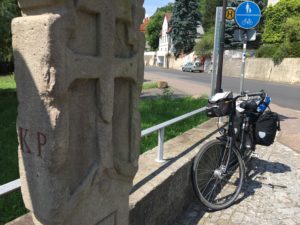
Vacha is not the only place where a former border overlaps with the one that separated East and West Germany between 1949 and 1990. Most of the “inner German border” (in Western usage) or “state border West” (the Eastern term) ran along the same line as previous borders between German entities of the time of the
Holy Roman Empire and its successor entities (like the various versions of Hesse). Throughout my expedition, I have seen old stone markers, often with the top painted over in yellow to show the demarcation line established by the Allied Powers after WWII.
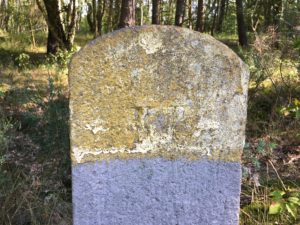
There are echoes of an even older, ethnic border from over a thousand years ago – the border, or buffer area, between the Germans and the Slavs. But that is another story and I will muster all my discipline not to veer off into that now…
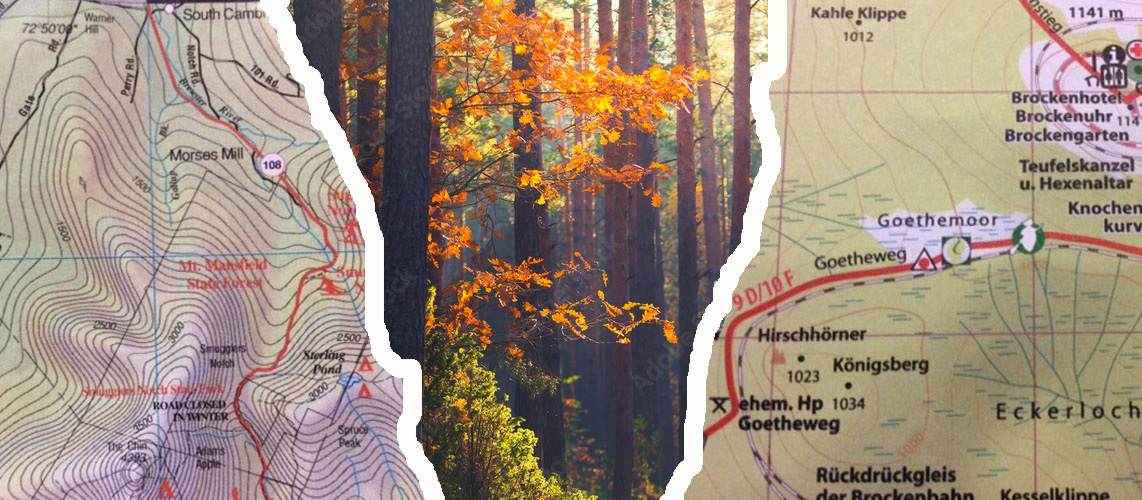
Kerstin, your accounts are mesmerizing and a real historical journey….can imagine that few Americans knew anything about these details. Thank you for your writing, and best wishes for your continued journey! Julie
Thank you Julie! So good to hear from you, and I am glad to know you are reading along!
Hi again Kerstin,
Another compelling entry from your journey.
Needless to say, when reading your description of the razed villages, I thought of archaeology. Do you know whether there has been any archaeological research of those sites and, if so, what has been learned from it?
Furthermore, would it indeed be possible to interview people who experienced the displacement from and destruction of their villages? In particular, it would be worth knowing why they were labeled “criminal elements” and what implications this designation had for them in both the short- and long-term.
Hugs,
Gerard
Hi Gerard,
contrary to appearances, I have not forgotten about your question! Through various email referrals, I just received this from Dr. Detlev Janzen from the Mecklenburg-Vorpommern office for historic preservation (auf deutsch for now; I’ll be happy to translate if you get stuck – am currently deep in the transcript of the Stammtisch meeting of the former border guards!):
“Bislang hat es keine Ausgrabungen im Bereich geschleifter Dörfer gegeben. Anlass für Ausgrabungen ist ja meistens eine Neubebauung; diese scheidet jedoch im Bereich der geschleiften Dörfer aus, weil die Flächen heute in der Regel nicht mehr bebaubar sind. Ein anderer Anlass für Ausgrabungen könnte in einem Forschungsinteresse bestehen. Bislang konzentriert sich die Forschung aber auf die Auswertung der historischen Quellen. Dafür gibt es natürlich gute Gründe, denn die historischen Quellen sind für die Hintergründe und den Verlauf der Zerstörung dieser Dörfer sehr viel aussagekräftiger als die archäologischen Quellen, mit denen sich im Zweifel nur ein massiver Zerstörungshorizont in der zweiten Hälfte des 20. Jahrhunderts nachweisen lassen wird. Es kann aber in Zukunft durchaus auch Fragestellungen geben, die sich (nur) mit archäologischen Mitteln, z. B. mit Ausgrabungen, beantworten lassen.”
[…] symbolizes not only the expulsions along the former border (see also this earlier posting about phantom villages), but expulsions everywhere: Of the Huguenots from France, Germans from Poland, Jews from just […]